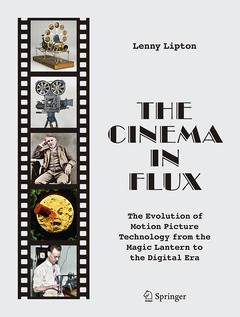The Cinema in Flux, 1st ed. 2021 The Evolution of Motion Picture Technology from the Magic Lantern to the Digital Era
Auteur : Lipton Lenny

The first of its kind, this book traces the evolution of motion picture technology in its entirety. Beginning with Huygens' magic lantern and ending in the current electronic era, it explains cinema?s scientific foundations and the development of parallel enabling technologies alongside the lives of the innovators. Product development issues, business and marketplace factors, the interaction of aesthetic and technological demands, and the patent system all play key roles in the tale.
The topics are covered sequentially, with detailed discussion of the transition from the magic lantern to Edison?s invention of the 35mm camera, the development of the celluloid cinema, and the transition from celluloid to digital. Unique and essential reading from a lifetime innovator in the field of cinema technology, this engaging and well-illustrated book will appeal to anyone interested in the history and science of cinema, from movie buffs to academics and members of the motion picture industry.
Introduction
The Cinema of Real Motion
1. Huygens and the Magic Lantern
2. The Magic Lanternists
3. Lantern Light and Glass
Apparent Motion: Discovered and Applied
4. Plateau Invents the Phenakistoscope
5. A Persistent Myth
6. The Zoëtrope and the Praxinoscope
7. Daguerre’s Photography
8. Fox Talbot’s Photography
9. Protocinematography
10. Muybridge and Anschütz
11. Chronophotography: Janssen, Marey, Demenÿ
The 35mm Medium
12. Edison, Dickson, and the Kineto Project13. The Kinetograph
14. The Kinetoscope: Projection’s Inspiration
15. Lambda, Mutoscope, and Bitzer
16. Jenkins and Armat: American Projection
17. The Lumières and the Europeans
18. Edison and the Trust
19. Porter the Filmmaker20. Porter and the Simplex
21. Camera Design before WWII
22. Camera Design after WWII
23. Ciné Lenses: Part I
24. Ciné Lenses: Part II
Sound
25. Silent Sound
26. Synchronizing the Phonograph
26. Electronics for Talking Shadows
27. The Origins of Sound-on-Film
28. One Man Bands: Lauste and Tykociner
30. Tri-Ergon
31. De Forest and Case
32. Phonofilm
33. William Fox Hears the Future
34. Vitaphone
35. Movietone
36. RCA vs. ERPI
37. William Fox vs. the Industry
38. Optical Sound Evolution
39. Multichannel, Magnetic, and Digital Sound
Color
40. Applied Color
41. Color Elucidated
42. Color Photography before the Movies
43. Urban and the Origins of Kinemacolor
44. The Rise and Fall of Kinemacolor
45. Additive Color after Kinemacolor
46. Subtractive Technologies
47. Kelly’s Color Microcosm
48. TruColor and Cinecolor
49. Two-Color Technicolor
50. Three-Color Technicolor
51. Agfa and Ansco Color
52. Eastman Color
Small Formats
53. Early Small Formats
54. 16mm
55. Kodachrome
56. Double 8mm and Super 8
The Big Wide Screen
57. The Shape of Screens to Come
58. Grandeur et al
59. Expanded Screen: The Interregnum Ends
60. This is Cinerama
61. Cinerama after Waller
62. CinemaScope
63. ‘Scope Variations
64. Wide Screen and VistaVision
65. Todd-AO
66. 65/70mm
67. IMAX and PLF Exhibition
The Stereoscopic Cinema
68. Early 3-D
69. Polarization Image Selection
70. 3-D in the Last Half of the 20th Century
Television
71. Vision at a Distance
72. Jenkins and Baird
73. Farnsworth
74. Zworykin
75. Broadcasting Begins
76. Color Wars: CBS vs. RCA
77. High Definition Television
78. Film to Video and the VTR
Electronic Cinema
79. Electronic Cinematography and CGI
80. The Origins of Digital Technology
81. Post-production and Industry Accommodation
82. A Brief History of Electronic Projection
83. Digital Projection and 3-D Converge
Chronicles the complete history of motion picture technology from the magic lantern to the current digital era
Shows how competing technological, cultural, economic, and legal factors shaped the cinema and TV industries
Split into digestible sections and accompanied by plenty of illustrations
Date de parution : 04-2021
Ouvrage de 795 p.
21x27.9 cm
Disponible chez l'éditeur (délai d'approvisionnement : 15 jours).
Prix indicatif 52,74 €
Ajouter au panierThèmes de The Cinema in Flux :
Mots-clés :
history of cinema technology; evolution of cinema technology; history of motion picture technology; Huygen's magic lantern; phenakistoscope; zoetrope; praxinoscope; history of sound in cinema; development of celluloid cinema; evolution of 35mm medium; color in motion picture; development of widescreen technology; stereoscopic cinema; development of 3D cinema



